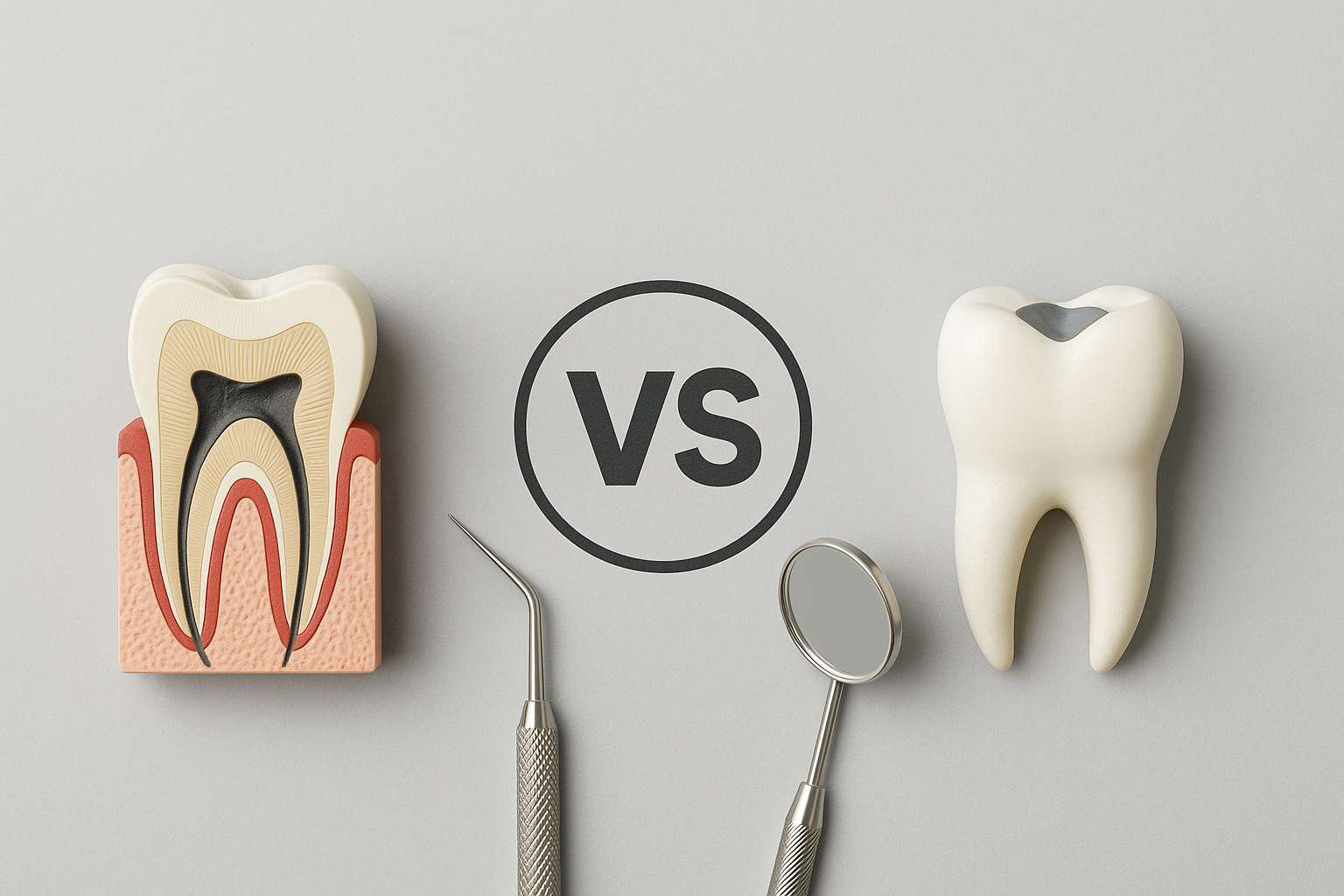
It depends on how deep the damage goes. At btyDENTAL Puyallup, many of our patients come in wondering whether they need a simple tooth filling or a root canal. The truth is, neither treatment is automatically better—it all comes down to how far the decay has progressed.
If the issue is caught early, a filling is often enough. But once the infection reaches the nerve of the tooth, a root canal might be the only way to save it. That’s why we always remind our patients: the sooner you get it checked, the more likely we can treat it.
What’s the Difference Between a Filling and a Root Canal?
Both fillings and root canals are designed to treat tooth decay, but they serve very different purposes. We usually recommend a filling when the cavity is small and hasn’t reached the deeper layers of the tooth.
The procedure involves removing the decayed portion and filling the space with tooth-colored material. But there are different types of tooth fillings you can choose from. Either way, the procedure will be quick, effective, and typically done in a single visit.
A root canal, on the other hand, is needed when the decay or infection has reached the pulp (the soft tissue inside the tooth that contains nerves and blood vessels).
In this case, simply patching the surface won’t stop the pain or prevent further damage. The infected pulp has to be removed, the area cleaned and sealed, and in most cases, a crown is placed on top to protect the tooth long term.
Think of it this way: a filling repairs the surface, while a root canal treats the problem at its core.
Signs You Might Need a Root Canal Instead of a Filling
Not all toothaches are created equal. We often see patients who assume they just need a quick filling, only to find out the issue goes deeper. So how can you tell if a root canal might be necessary? Here are a few common signs:
- Lingering pain after eating or drinking, especially hot or cold foods
- Throbbing or sharp pain that doesn’t go away
- Swelling or tenderness in the gums near the affected tooth
- Darkening or discoloration of the tooth
- A pimple-like bump on the gums (a sign of infection or abscess)
If you’re experiencing any of these symptoms, it’s best to come in for an exam. We’ll take an X-ray, check the health of your tooth’s pulp, and walk you through the best treatment option. Catching the problem early may still make a filling possible. But if the infection has spread, a root canal could be the only way to save the tooth.
Can a Filling Prevent a Root Canal?
In many cases, yes. That’s why dentists recommend regular checkups to catch cavities before they turn into deeper infections. If tooth decay is spotted early, a simple filling can usually fix the problem and help you avoid more involved treatments later on.
But if the decay reaches the pulp, a filling won’t be enough. At that point, a root canal becomes necessary to clean out the infection and save the tooth. Even if the pain seems minor, delaying treatment gives bacteria more time to spread.
At btyDENTAL Puyallup, we’ve seen patients avoid root canals altogether simply by acting fast. If you’re experiencing sensitivity or discomfort, now’s the time to visit a local Puyallup dentist and get your tooth evaluated before it worsens.
Cost and Recovery Time: Filling vs Root Canal in Puyallup
The cost and healing time for each treatment can vary depending on the clinic, insurance coverage, and how severe the problem is. Here’s a general comparison based on what patients typically experience in Puyallup:
| Treatment | Average Cost in Puyallup | Visits Needed | Recovery Time | Notes |
| Filling | $150 – $400 | 1 visit | 1–2 days | Best for small to moderate cavities |
| Root Canal | $800 – $1,500 (molar) | 1–2 visits | 2–5 days | May require a crown after treatment |
| Crown (if needed) | $1,000 – $1,300 | 1–2 visits | Additional healing after placement | Protects the tooth long term |
Most dental offices in Puyallup accept major insurance plans and offer financing options if you’re concerned about cost. If you’re unsure what your plan covers, our team at btyDENTAL Puyallup can help you check your benefits before starting any treatment.
Which One Is Right for You?
The best way to know whether you need a filling or a root canal is to get a dental exam and X-ray. Pain level alone isn’t always a clear indicator. Fillings will last for years. However, some deep cavities might not hurt much but still require a root canal, while others that feel sensitive may only need a simple filling.
If you’re in pain, noticing sensitivity, or haven’t been to the dentist in a while, don’t wait. The sooner you get checked, the more options you’ll have and the more likely you’ll avoid serious problems down the line.
Conclusion
When it comes to choosing between a root canal and a filling, it’s not about which one is “better”—it’s about what your tooth actually needs. A filling is enough for small cavities, but once the infection reaches the nerve, a root canal is often the only way to save the tooth.
If you’re in Puyallup and unsure what treatment is right for you, visit a trusted local provider like btyDENTAL Puyallup. Whether it’s a quick filling or a full root canal, you’ll get clear answers and care that fits your situation. Don’t wait for the pain to get worse. Schedule an appointment today!

